November 2025 Digital Magazine
November 2025 Digital Magazine
November 2025 Digital Magazine
Russia’s invasion of Ukraine represents a deterrence failure even though Ukraine is unconquered and nuclear weapons remain unused.
November 2025
By Christopher F. Chyba
Russia invaded Ukraine February 24, 2022, after having occupied Crimea and part of the Donbas eight years earlier. The invasion represents a deterrence failure (although perhaps an unavoidable one) on the part of the United States, its NATO allies, and Ukraine, despite timely intelligence warning. But Ukraine remains unconquered and nuclear weapons remain unused. Even while acknowledging the enormous suffering caused by the invasion and occupation, these remain—at least for now—two important successes of the Western response.
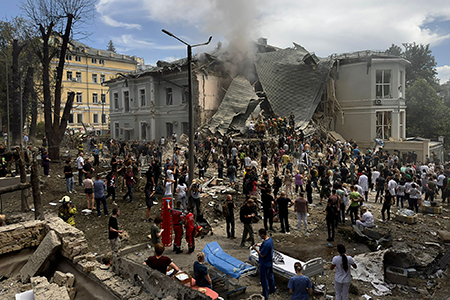
The Western powers were playing a weak deterrence hand prior to the invasion because Ukraine was not, and still is not, a member of NATO. Even in the face of Western preparations, warnings, and targeted intelligence revelations prior to the invasion,1 Russia knew that there was no treaty obligation for NATO to come to Ukraine’s defense, and it had a “no-limits” partnership with China that could lessen the sting of any resulting Western sanctions.2
True, the Budapest Memorandum had been signed by Ukraine, Russia, the United Kingdom, and the United States in 1994 upon Ukraine’s decision to eliminate the nuclear weapons left on its soil by the Soviet Union and to join the nuclear Nonproliferation Treaty (NPT).3 The memorandum recorded its signatories’ commitment to “respect the independence and sovereignty and the existing borders of Ukraine” and to “refrain from the threat or use of force against the territorial integrity or political independence of Ukraine.” But there were no consequences specified in the event of violation, apart from seeking action from the UN Security Council, a body on which all the signatories but Ukraine held veto power.4
In 2014 and 2022, Moscow simply swept its 1994 commitments aside. Russia sought to coerce Ukraine and deter the West by using kinetic force, information warfare, and implicit nuclear threats, consistent with its own understanding of “strategic deterrence,” a phrase it appears to interpret more broadly than the West.5 Explicit and implied references to nuclear weapons were used by Russia to deter direct NATO intervention and to limit the quantity, quality, and employment of Western military aid, and possibly also to convey that Russia, or at least Russian President Vladimir Putin, views the fate of Ukraine as bordering on existential for Russia.
Moscow planned to seize Kyiv within days and all of Ukraine within weeks or months of the outbreak of war, creating a fait accompli. When a remarkable Ukrainian resistance aided by Western intelligence and materiel thwarted this plan, Russia settled into a grinding, brutal ground and aerial-bombardment war that continues to this day. According to the UN Human Rights Council, Russian occupation has featured systematic torture, including by sexual violence, of both prisoners of war and civilians, as well as targeting civilian infrastructure including hospitals. That same UN body verified the unlawful transfer of Ukrainian children to the Russian government.6 Yale University’s Humanitarian Research Lab has documented the associated Russian system of coerced adoption.7 The International Criminal Court has indicted Putin and his commissioner for children’s rights for the war crime of unlawful deportation of children.8
Throughout all of this, Russia’s nuclear capabilities remain omnipresent, hovering in the background and frequently invoked more concretely. Moscow’s cacophony of nuclear signals has included claims to place its nuclear weapons on heightened alert, threats to resume nuclear testing, the suspension of its participation in the New Strategic Arms Reduction Treaty(New START) , the movement of Russian tactical nuclear weapons to Belarus, a new nuclear doctrine with a lower threshold for use, nuclear readiness exercises, repeated references to its new Sarmat heavy intercontinental ballistic missile (ICBM), and veiled and sometimes explicit references to being prepared for nuclear war.9
It is still early to assess the longer-term implications of Russia’s invasion and behavior in its war against Ukraine. But questions of nuclear deterrence are so vital for peace and survival that even amid the ongoing war it is important to ask what lessons already might be tentatively drawn. What light is shed from events prior to the 2022 invasion? What is being learned about implicit and explicit nuclear threats, deterrence, and coercion during the war itself? Are there implications for how the United States and its allies should assess the U.S. nuclear posture for the coming decades, as the world enters a landscape of three nuclear peers with China in some partnership with a Russia behaving belligerently in Eastern Europe?
Immediate European Consequences
The brutality of Russia’s occupation in Ukraine is a reminder of the potential cost of deterrence failure. At the same time, the invasion and occupation have had broader consequences, some damaging for Russia’s strategic position, even apart from its losing perhaps tens of thousands of pieces of equipment and sustaining upward to an estimated 1 million casualties.10
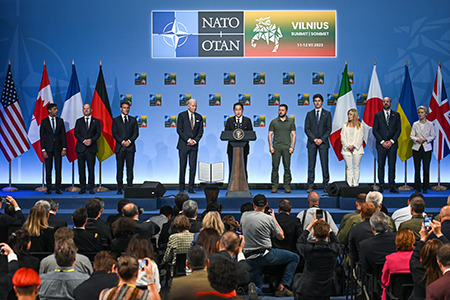
Finland and Sweden had not previously been part of NATO, but the fate of Ukraine emphasized the danger of proximity to Putin’s Russia without having the defense commitment of that alliance. Senior officials from each country have been explicit that their NATO membership was the direct result of Russia’s invasion.11 The two countries have now joined NATO, lengthening Russia’s border with the Western military alliance by 830 miles. NATO countries had been pressured by successive U.S. administrations to increase the fraction of their GDP devoted to defense, but after the invasion and under strong pressure from the Trump administration, these countries have now agreed to raise their core defense and broader security-related investments to 5 percent of GDP by 2035, up from the current average of 2.6 percent.12
Perhaps less remarked upon has been NATO’s shift at its 2023 summit in Vilnius, Lithuania, from a posture based on forward presence to one based on forward defense, a change driven by reminders of the nature of wartime occupation practiced by the Russian army in Ukraine, and likely informed by an evaluation of Putin’s vision for Russia.13 As one salient example, Western analysts have long noted the vulnerability of the Estonian city Narva, a city on the Estonian-Russian border, that is 88 percent ethnic Russian and physically closer to St. Petersburg than to the Estonian capital, Tallinn.14 On June 9, 2022, Putin made remarks in a casual setting to young Russians in which he praised Peter the Great’s 1704 victory in the Great Northern War, when Russia captured Narva from Sweden. He described Narva and other captured regions as having been under Russian control “from time immemorial” so that they were not being conquered by Peter the Great, he said, they were only being “returned.”15
The implicit comparison with Ukraine or indeed themselves could not have been missed by Russia’s northern neighbors. Two weeks later, Estonian Prime Minister Kaja Kallas decried what she described as NATO’s plan to lose her country to a Russian invasion “and liberate it afterwards,” in about six months. She said that Russian atrocities in the Ukrainian city Bucha 80 days after the invasion showed that NATO’s “tripwire concept doesn’t really work.”16 The nature of the Russian occupation, and the apparent credibility of Putin’s desire to continue the “gathering of Russia” pushed NATO toward a forward defense, one that would somehow have to be immediately effective—a task that might appear to encourage consideration of battlefield nuclear weapons.
Even while NATO strengthens its conventional forces and alters its force posture, France and the United Kingdom have taken steps to increase the European role in the nuclear protection of the alliance as a whole. In July 2025, they issued the Northwood Declaration, announcing that they “agree that there is no extreme threat to Europe that would not prompt a response by our two nations,” and that while independent, their nuclear forces “can be coordinated and contribute significantly to the overall security of the alliance.”17
Reasons for Caution
There are broader implications for nuclear deterrence beyond these immediate consequences of Russia’s invasion. Yet one should be wary. After all, there is still a fierce debate about nuclear deterrence during the Cold War, now a quarter-century distant and with a historical understanding benefitting from the partial examination of archives from the two primary nuclear powers. Scholars have nevertheless not resolved the question of whether nuclear deterrence prevented the Soviet Union from invading Western Europe, or if, instead, the Soviets never intended to attack,18 or whether deterrence by the prospect of another major-power war might in itself have been sufficient even absent the nuclear danger.
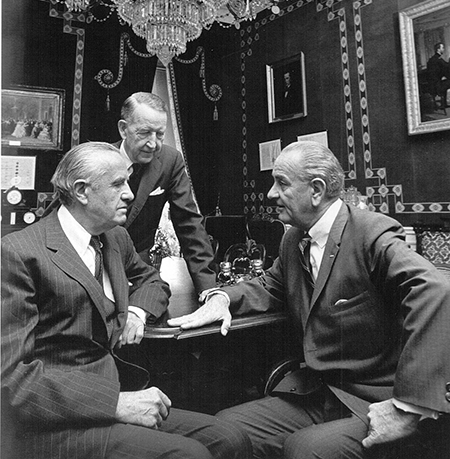
Are nuclear weapons responsible for the “long peace”—the absence of direct major-power war since 1945, however much other savagery may have taken place over those decades? Even more imposing is the question of whether nuclear weapons should be credited, albeit perversely, with preventing the outbreak of thermonuclear war? This assertion must contend at least with the argument that certain near-catastrophic events, such as the Berlin and Cuban missile crises, might not have happened at all in the absence of nuclear weapons.19 Johns Hopkins University historian Francis Gavin dryly notes regarding thermonuclear war that, “We are understandably eager to have an explanation for the most important nonevent in human history.”20
Yet we do not; so modesty in assertions about nuclear forces and deterrence is called for. But national security officials are known often to be overly certain in their professional judgments. A recent study of over 63,000 responses to contemporary international security questions made by almost 1,900 national security officials from 40 NATO allies and partners found the responders to be “overwhelmingly overconfident.”21 As one example, when such officials said a statement had a 100 percent chance of being true, they were wrong over 25 percent of the time. Anyone with experience in interagency meetings in Washington has seen the social power of confident statements made with apparent certainty at the conference table—and the bureaucratic weakness of admitting to uncertainty. This is a broad cultural failing.
Deterrence and Survival
At the end of World War II, scientists, defense intellectuals, and policymakers grappled with how humanity could survive in the face of the new atom-bomb technology, given the fraught reality of international politics. One proposed answer was international control, perhaps necessitating the establishment of a supranational authority that to some extent would transcend the anarchic world order.
Another was the theory of deterrence. The current international situation has elements of both. There is an international control regime, consisting of the NPT and the International Atomic Energy Agency, among other mechanisms, meant to curtail horizontal proliferation, as well as NPT Article VI and the Treaty for the Prohibition of Nuclear Weapons (unsigned by every state with nuclear weapons), meant to lead to their complete elimination. There is also deterrence, together with strategic arms control in the U.S.-Russia case, as a central mechanism for strategic stability among the nuclear powers.
But much of this familiar, if frustrating and imperfect, architecture is breaking down. China is now rapidly expanding its nuclear arsenal toward U.S.-Russian levels, and Russia has swathed its invasion of Ukraine in implicit nuclear threats. Brown University political scientist Nina Tannenwald has argued that that war so far shows that the “nuclear taboo” continues to hold in its most basic sense; there have been, after all, no nuclear explosions.22 But one could not say that nuclear weapons have gone unused in the war, most overtly by Russia in its efforts to manipulate and limit the Western response.
Admittedly, whenever nuclear weapons exist, they are being “used” by exerting influence in international relations. But this overt emphasis on nuclear weapons during wartime by Russia, one of the five permanent members of the UN Security Council and a nuclear-weapon-state legally bound by Article VI of the NPT, overshadows the post-Cold War hope that the role of nuclear weapons in international relations might, at the least, become less salient.23 Moreover, virtually all of the nuclear powers continue updating and upgrading their nuclear arsenals, including with some new technologies that could make stability harder to maintain.24
When New START, the 2011 treaty, expires in February 2026 there will no longer be legally binding caps on U.S. and Russian strategic warhead numbers, although it seems possible that these limits may be extended by at least another year. If each of the three major nuclear powers—Russia, the United States and China—concludes that it must match the combined arsenals of the other two, an endless arms race is before us. The ultimate solution to this dangerous and bankrupting spiral is either purposeful restraint or diplomatic agreement. Until those are realized, however—and even afterward, as long as nuclear weapons or the ability to reconstitute them exist among hostile powers—international security will also rely on deterrence of one kind or another.
Deterrence in the United States is often understood as an effort to affect the cost-benefit calculation of one’s adversary. This can be done in two ways. One is by denial, through efforts to convince the adversary that their planned actions will not succeed—at least not at an acceptable level, given the costs they will suffer. The other is by the threat of punishment, through efforts to convince the adversary that the price they will pay exceeds whatever benefits they might gain.
Both efforts, but especially the second, are based in part on psychology. In order for deterrence by the threat of punishment to succeed, the threat must be effectively communicated, it must seem sufficiently credible, and it must appear sufficiently terrible. The adversary must also be assured that if they do not take the action being deterred, they will not be punished. The central claim of what deterrence theorists have called the “nuclear revolution” is that thermonuclear (hydrogen fusion) weapons mated with ballistic missiles provide the ultimate deterrent. It is credible because there remains no credible sufficient means of defense, whatever hopes for the eventual “Golden Dome” may be; likewise is it horrific, because a single heavy warhead can obliterate a city, thereby preventing a nuclear attack by another rationally governed power. Major-power war, therefore, should also be deterred, because there is just too much risk that such a war would escalate to nuclear-weapon use. In the game theorist Thomas Schelling’s phrase, nuclear deterrence is effective in part because it is “the threat that leaves something to chance.”25 The possibility of inadvertent escalation, of a catastrophic loss of control over the situation, is therefore built into the ostensibly rational calculations made to sustain peace through this balance of terror.
The Fog of Deterrence
For this sort of “deterrence by cost-benefit analysis” to work, one had better have a reasonably good understanding of the motives of their adversary and of what they hold dear. In light of their grievances, ambitions, and fears, what costs would they consider too high to pay for what they hope to gain? Viewed through this lens, the months immediately prior to the 2022 Russian invasion of Ukraine offer limited comfort.
U.S. intelligence and senior Biden administration officials observed Russian preparations for war and concluded correctly that Russia was not bluffing and intended to invade. In working to convince allies of this, U.S. Secretary of State Antony Blinken acknowledged how wrong the United States had been with its weapons-of-mass-destruction assessments two decades earlier in the leadup to the Iraq War. The most prominent had been when U.S. Secretary of State Colin Powell delivered a confident but largely incorrect presentation to the UN Security Council.26

In 2021 and 2022, a number of senior French and German officials, including intelligence officials, argued that an invasion of Ukraine would have too high a cost for the Russians and that other options were more likely. The head of Germany’s Federal Intelligence Service is reported to have told the U.S. Central Intelligence Agency director that the Russian invasion “was not going to happen.” The French intelligence service reportedly felt that an invasion would have too “monstrous” a cost for Moscow. Similar incorrect utility-based arguments were made by many Western nongovernmental analysts and apparently by some analysts in Moscow as well.27
Some of the mistaken Western assessments may have resulted from a form of mirror-imaging—expecting one’s adversary to assess a situation according to one’s own values or preferences—coupled with a lack of strategic empathy, namely assessing decision-making criteria that differ from one’s own as being irrational. But all that is necessary for Putin’s decisions to qualify as rational is for them to follow logically from his premises, and Putin published an essay in 2021 that seemed to display these. Titled “On the Historical Unity of Russians and Ukrainians,” Putin surveyed 1,200 years of history, claiming to show that “Russians, Ukrainians, and Belarusians are all descendants of Ancient Rus” and that Kyiv had been identified by Oleg the Wise 1,100 years ago as “the mother of all Russian cities.” He concluded that contemporary Ukraine had been subjected by “western authors” to a “forced change of identity,” but that nevertheless Russians and Ukrainians remain “one people.”28
To be fair, Putin’s apparent sentiments do not by themselves tell an analyst, Western or Russian, what price the Russian leader would be willing to pay to rebuild the historical union that he asserts. They do not tell the West how many Russian or other lives lost Putin views as acceptable to achieve his goals. Nor do they make clear the extent to which his public views are really his own, or a façade. But nuclear deterrence depends exactly on making such assessments of one’s adversaries, and making them correctly, or at least correctly enough. Successful deterrence depends on understanding what price adversaries would pay for their goals, and what price would be too high.
The imperfect track record of analysts should not be a surprise: personalist regimes such as Putin’s Russia are especially hard to predict because their actions depend so strongly on what lies within the skull of one individual minimally constrained by government bureaucracy.29 This dilemma will only worsen at the threshold of nuclear war because of the compressed decision-time that ballistic missiles and other hypersonic technologies will force on heads of state. With respect to nuclear war, all three major nuclear powers now have personalist governments of varying degrees, making it more challenging for them to anticipate and calibrate one another’s behavior.
Such calculations will be especially consequential during a crisis. Observations from the leadup to the invasion of Ukraine reinforce lessons, perhaps too quickly forgotten, from the Cuban missile crisis. At that time President John Kennedy included on his Executive Committee of the National Security Council Llewellyn “Tommy” Thompson, a career diplomat and ambassador to the Soviet Union who was fluent in Russian and had worked closely with Soviet Premier Nikita Krushchev. Kennedy’s secretary of defense, Robert McNamara, later described Thompson’s role in interpreting Krushchev’s messaging and motivations during the crisis as critical to the outcome.30 Kennedy evidently understood the need for strategic empathy.
The leadup to the Russian invasion of Ukraine suggests that even with an adversary as familiar as Russia, interpreting other powers’ motivations and tolerance for pain is challenging. In this respect, a crisis with China would likely prove more fraught. Tufts political scientist David Logan skeptically asks, “Are they reading Schelling in Beijing?” and ponders whether certain Chinese decisions are an effort to manipulate risk to enhance deterrence along the lines that U.S. deterrence theory might predict, or simply driven by China-specific factors.31 University of Pennsylvania political scientist Fiona Cunningham argues that China is adopting an asymmetric deterrence strategy quite different from those employed by the United States and Russia.32 Both scholars are fluent speakers and readers of the Chinese open literature.
An important lesson about deterrence ad bellum from the Cold War and Ukraine is that prior to, and perhaps especially amid, a crisis with a nuclear country the United States will need more figures like Tommy Thompson, and a president who is self-confident and thoughtful enough to ensure that deep expertise in the relevant language and foreign political and military culture is present when nuclear decisions are made. University political science departments might query the extent to which they are encouraging such scholars to flourish.33 Congress and presidential administrations might seriously consider whether such voices are respected and heard, especially when their message is unwelcome.
Testing Deterrence in Bello
It is too easy for a bloodless discussion of nuclear deterrence to lose sight of the scale of human suffering implied in that discussion. Yet because the ideas are so significant and the stakes so high, they nevertheless need to be examined analytically and skeptically.34 It is also important to ask to what extent the putative verities of deterrence as developed and taught in the United States in and since the Cold War are objective truths or, at the other extreme, U.S. constructs that may be only partly accepted or even understood by U.S. adversaries. The war in Ukraine sheds some light on these issues.
Cold War deterrence theorists argued that nuclear war is so horrifying that its very prospect ironically gives state adversaries the freedom to engage in violence below some threshold. The chance of nuclear catastrophe, should hostilities be pushed too far, generates this stability-instability paradox by assuring nuclear powers that recklessness will in the end be curtailed because adversaries will step back from the brink. Yet the fear that this “guarantee” might fail and disaster nevertheless occur through accidents or inadvertence—fears justified by Cold War history—itself perversely enhances the effectiveness of nuclear deterrence. Russia and the United States, along with Britain and France, are fighting by proxy on the battlefields and in the cities of Ukraine and to a much lesser extent, Russia, conscious that escalation to nuclear-weapon use is possible, but exercising some freedom of action below that threshold. In the words of University of Minnesota political scientist Mark Bell, nuclear weapons “act as a shield behind which Russia can engage in aggression.”35 Nuclear weapons not only deter, but they enable.
A central uncertainty about the stability-instability paradox is identifying the line beyond which disaster will come. Herman Kahn, perhaps the grimmest of the Cold War’s serious theorists, thought that it might lie above the initial use of nuclear weapons. He did not believe that the horror of nuclear war would necessarily prevent it from ever again taking place, so the United States had to think seriously about levels of escalation beyond the nuclear threshold.36
Should a first nuclear weapon be used, Kahn argued, deterrence of the very worst might come higher on the ladder of escalation. For this to be credible, adequate command, control, and communications would have to persist during nuclear war, and fear or rage not overwhelm governments’ calibrated nuclear signaling. If all went well, a political leader might convince the adversary that they could not further escalate without the advantage going to the other side (“escalation dominance”), or perhaps more credibly, without triggering the apocalypse. Kahn’s “metaphors and scenarios” were conceived in the world of 1965; the Ukraine war calls for more intensive examination of intra-war deterrence for scenarios in the world of 2025.37
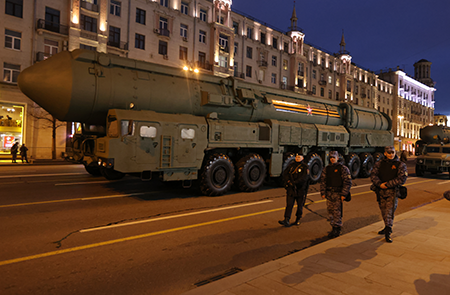
Prior to the Ukraine invasion, Russia had appeared to embrace a limited version of Kahn’s view in its notion of “escalate to de-escalate.” In this concept, in the event of a sufficiently successful NATO conventional attack on Russia, Russia would detonate a tactical nuclear weapon. This would demonstrate Russia’s resolve and make NATO sit up at attention and cease hostilities through pure fear of what otherwise might follow. What was less clear was the extent to which “escalate to de-escalate” was official Russian doctrine, whether that would matter anyway given that such a decision would de facto likely be made by just one man, and at what threshold and for what purpose that man might decide that a nuclear detonation was called for.
Russia’s frequent references to nuclear weapons at the time of its invasion of Ukraine and throughout the war were mated with particular concrete actions. The decision to move tactical nuclear weapons to Belarus did not meaningfully enhance Russian capabilities, but introduced an additional element of risk that through mistake or inadvertence the weapons might be used; it seems that Schelling was, so to speak, being read in Moscow. NATO took at least some of Russia’s actions seriously, perhaps most so in the fall of 2022, when Russia’s forces were in retreat and Putin’s was citing the “precedent” of U.S. nuclear use in the Second World War. Reports in the press claimed that U.S. intelligence assessed that Russia’s probability of nuclear use might rise as high as 50 percent.38
NATO’s approach was to test repeatedly Russia’s possible red lines. If Moscow was going to manipulate risk to deter NATO’s support of Ukraine, Washington was going to reduce the uncertainty by escalating incrementally in terms of conventional weapons provided to Ukraine or by relaxing restrictions on their use, and then watch for any tangible reaction from Moscow. If Moscow’s reaction was rhetorical only, the constraints initially set by President Joe Biden early in the war could be relaxed a step further.39
So far, both NATO and Moscow have been deterred. Russia repeatedly implied the potential of nuclear-weapon use but refrained from actually doing so. It also decided not to strike Ukrainian arms supply lines within NATO countries, although recently Russia seems to have engaged in multiple incursions of NATO airspace and other forms of harassment of European nations and testing of the alliance. Whether limiting itself to these hybrid activities provides evidence for nuclear deterrence as such or more broadly as deterrence due to the risk of entering into direct war with a far more powerful military alliance is unclear. Perhaps it is even unclear to the Russians themselves. But they may hope that by probing and testing the alliance, clarity may come.
Uncertain Conclusions
The invasion of Ukraine and Russia’s frequent invocation of nuclear weapons reinforces the sense that this nuclear moment is different, and grimmer, than what the world knew for the first decades after the Cold War. Perhaps even more powerful in this regard is China’s rapid nuclear expansion, and the upgrading and possible expansion of other nuclear arsenals around the world. What are key, albeit necessarily tentative, conclusions from this analysis of nuclear weapons in the Ukraine war?
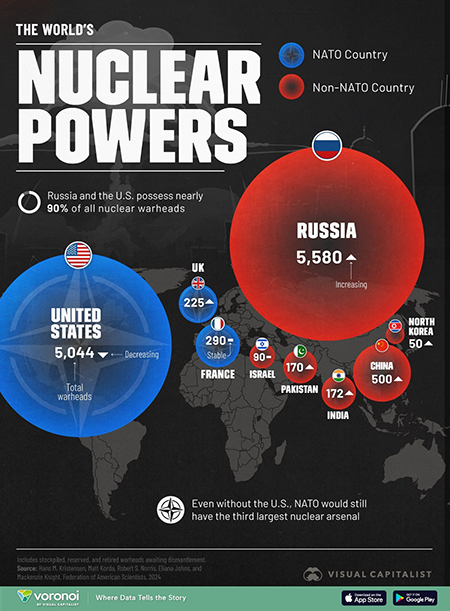
Russia has not openly attacked NATO despite NATO’s supplies of materiel and intelligence to Ukraine that continue to bloody Russia on the battlefield. It is not easy to disentangle deterrence by the prospect of major-power war from deterrence by the threat of nuclear weapons, especially since the first could well lead to the second. But deterrence at the level of NATO has so far been effective despite Russia’s ongoing testing of the alliance, and despite the smaller tactical nuclear arsenal held by NATO compared to that of Russia. In addition to its thousands of strategic warheads, according to open-source estimates, NATO can call upon perhaps 200 variable-yield gravity bombs, hundreds of variable-yield, air-launched cruise missiles, and a small number of low-yield warheads on submarine-launched ballistic missiles.40 The existing quantitative imbalance has not yet led Russia to escalate to more than probes of NATO defenses.
Before the war, Ukraine was “protected” only by the Budapest Memorandum, which committed no country to act in its defense. Although most NATO countries do not fall within Putin’s apparent desire to gather in the historical Russian people as he conceives them, Putin might well see Narva in that light. Yet Estonia is part of NATO, albeit terribly exposed, and he has not attacked. Article 5 of the North Atlantic Treaty appears to matter.
Russia’s failure to attack in the Baltic states may be overdetermined, however, since it has its hands full in Ukraine. Were Ukraine to fall or be abandoned by the West to its fate, Putin might feel fewer constraints and reach his own feral conclusions about the commitment and steadfastness of the United States.
For deterrence as commonly understood in the United States to work, it is vital to understand, at least crudely, the motives and values of the adversary. It is daunting that even with an adversary as familiar as Russia, this proved challenging for some European allies during the leadup to the 2022 invasion. This will likely prove all the more challenging with an adversary such as China, with whom the United States has a much less extensive baseline in nuclear weapons discussions and signaling, and whose thinking about nuclear weapons may not be so easily fit into Western boxes. China may have concluded that Russia’s nuclear signaling in the Ukraine war effectively has constrained Western actions, and that it too might “achieve the coercive leverage of nuclear weapons without crossing the threshold of explicitly threatening nuclear use.”41
Expertise of the type that is built up over the course of a career is essential to understanding Russian and Chinese motives. It needs to be fostered if not rebuilt by universities and welcomed by Congress and the executive branch. Funding for language and area studies, coupled with respect for policy-relevant regional expertise in hiring and retention decisions, would be good places to start.
An important element of U.S. grand strategy that persisted from early in the Cold War to at least the second Trump administration is to discourage the spread of nuclear weapons to other countries, including to U.S. allies. The United States has aggressively sought to curtail the pursuit of nuclear weapons not just by adversaries such as Iran, Iraq, Libya, and North Korea, but also by friends such as Germany, South Korea, and Taiwan. Underlying U.S. motivations include concern that more countries with nuclear weapons mean more opportunities for nuclear accidents or for escalation to the horror of nuclear war; that the approach to nuclear weapons capabilities by certain allies could trigger preventive war by an adversary; that a nuclear-armed foe could directly attack the United States, and that a nuclear-armed ally could pull the United States into a nuclear conflict. Another concern is that nuclear weapons in the hands of other countries could restrict U.S. freedom of action, deterring Washington from certain paths and enabling its adversaries to act with greater impunity. The war in Ukraine seems to demonstrate exactly this last concern.
Russia knows that it would not win a conventional war with NATO. If one lesson from the Russian war in Ukraine is that nuclear weapons enable, another is that a defense commitment such as Article 5 can be a powerful countervailing force, provided the United States does not fritter it away. Deterrence may depend more on maintaining and communicating the durability of U.S. security commitments than on the details of nuclear capability.
ENDNOTES
1. Kristian Gustafson, Dan Lomas, Steven Wagner, Neveen Shaaban Abdalla, and Philip H. J. Davies, “Intelligence warning in the Ukraine war, Autumn 2021 – Summer 2022,” Intelligence and National Security, Vol. 39, No. 3 (2024): pp. 400-419.
2. China and Russia announced their “no-limits” bilateral partnership in Beijing three weeks before Russia’s invasion of Ukraine. See “Joint Statement of the Russian Federation and the People’s Republic of China on the International Relations Entering a New Era and the Global Sustainable Development,” President of the Russian Federation, February 4, 2022.
3. “Memorandum on security assurances in connection with Ukraine’s accession to the Treaty on the Non-Proliferation of Nuclear Weapons,” United Nations, December 5, 1994.
4. On February 7, 2022, the UN Security Council adopted Resolution S/RES/2623, which called for an emergency special session of the General Assembly regarding Ukraine because the Security Council’s permanent members were deadlocked. On February 24, 2025, it passed resolution S/RES/2774, which mourned the “tragic loss of life throughout the Russian Federation-Ukraine conflict” and urged a “swift end to the conflict and a lasting peace.” Proposed amendments by European states to, in the words of the Danish representative, “reject the false equivalence between aggressor and victim” were vetoed by Russia (the United States abstained).
5. Russia’s understanding of “strategic deterrence” (strategicheskoe sderzhivanie) seems more akin to the Western phrase “all-domain coercion.” See Dmitry Adamsky, The Russian Way of Deterrence: Strategic Culture, Coercion, and War, Stanford University Press, 2024.
6. See the second and third reports of the Independent International Commission of Inquiry on Ukraine, United Nations Human Rights Council, March 18, 2024, and October 25, 2024. Ukraine estimates the number of unlawfully deported children at over 19,500, per Bring Kids Back UA.
7. Nathaniel A. Raymond, Oona A. Hathaway, Caitlin N. Howarth, and Kaveh Khoshnood, et al., “Russia’s Systematic Program of Coerced Adoption and Fostering of Ukraine’s Children,” Yale School of Public Health Humanitarian Research Lab, December 3, 2024.
8. International Criminal Court, “Situation in Ukraine: ICC Judges Issue Arrest Warrants against Vladimir Vladimirovich Putin and Maria Alekseyevna Lvova-Belova,” March 17, 2023.
9. For a timeline, see Claire Mills, “Russia’s Use of Nuclear Threats During the Ukraine Conflict,” UK House of Commons Library Research Briefing, December 20, 2024.
10. This includes as many as 250,000 fatalities. See Seth G. Jones and Riley McCabe, “Russia’s Battlefield Woes in Ukraine,” Center for Strategic and International Studies, June 3, 2025.
11. See, for example, Guardian News on YouTube, “Boris Johnson Holds Press Conference with Finnish President,” loc. 24:37-26:40, and Tobias Billström, “Why Sweden Joined NATO - a Paradigm Shift in Sweden’s Foreign and Security Policy” speech, April 17, 2024.
12. North Atlantic Treaty Organization, “The Hague Summit Declaration,” June 25, 2025.
13. Marta Kepe, “From Forward Presence to Forward Defense: NATO’s Defense of the Baltics,” Real Clear Defense, February 14, 2024.
14. Matthew Evangelista, “A ‘Nuclear Umbrella’ for Ukraine? Precedents and Possibilities for Postwar European Security,” International Security 48 (3), winter 2023/24, pp. 7-50.
15. Vladimir Putin, “Meeting with Young Entrepreneurs, Engineers, and Scientists,” President of the Russian Federation, June 9, 2022.
16. Richard Milne, “Estonia’s PM Says Country Would Be ‘Wiped from Map’ Under Existing Nato Plans,” Financial Times, June 20, 2022.
17. Statement by the United Kingdom and the French Republic on Nuclear Policy and Cooperation (Northwood Declaration), July 10, 2025.
18. Vojtech Mastny, “Imagining War in Europe: Soviet Strategic Planning,” in Vojtech Mastny, Sven G. Holtsmark and Andreas Wenger, eds., War Plans and Alliances in the Cold War, Routledge, 2006, pp. 15-45.
19. Marc Trachtenberg, A Constructed Peace: The Making of the European Settlement, 1945-1963 (Princeton University Press, 1999), Part III.
20. Francis J. Gavin, Nuclear Weapons and American Grand Strategy, Brookings Institution Press, 2020, p. 147.
21. Jeffrey Friedman, “The World is More Uncertain than You Think: Assessing and Combating Overconfidence Among 2,000 National Security Officials,” The Texas National Security Review 8 (4), Fall 2025, pp. 34-48.
22. Nina Tannenwald, “The Bomb in the Background: What the War in Ukraine has Revealed about Nuclear Weapons,” Foreign Affairs, February 24, 2023.
23. Veiled or ambiguous nuclear threats have also been made by the United States, although not with the same frequency as Russia over the past three years. In 2018, U.S. President Trump warned North Korea that his “nuclear button” was “much bigger and more powerful” than that of Korea’s Kim Jong Un. On August 1, 2025, Trump posted on social media that he had “ordered two nuclear submarines” to be repositioned in response to former Russian President Dmitri Medvedev’s July 31 social media references to the apocalypse and to strategic nuclear systems. (David E. Sanger, “Trump Said He Ordered Subs Repositioned in Rare Nuclear Threat to Russia,” The New York Times, August 1, 2025.) With no sense of irony, Putin’s spokesman, Dmitry Peskov, then replied that “Of course, we believe that everyone should be very, very careful with nuclear rhetoric.” (See Dmitry Antonov and Mark Trevelyan, “Kremlin plays down Trump’s submarine order, urges caution on nuclear rhetoric,” Reuters, August 4, 2025.)
24. Christopher F. Chyba, “New Technologies and Strategic Stability,” Daedalus, Vol. 149, No. 2 (Spring 2020): pp. 150-170.
25. Thomas C. Schelling, The Strategy of Conflict, Harvard University Press, 1960, 1980, pp. 187-194.
26. Blinken told the UN Security Council: “Now, I am mindful that some have called into question our information, recalling previous instances where intelligence ultimately did not bear out. But let me be clear: I am here today, not to start a war, but to prevent one.” See Antony Blinken, “On Russia’s Threat to Peace and Security at the UN Security Council,” February 17, 2022.
27. Jonas J. Driedger and Mikhail Polianskii, “Utility-based Predictions of Military Escalation: Why Experts Forecasted Russia Would Not Invade Ukraine,” Contemporary Security Policy, Vol. 44, No. 4 (2023): pp. 544-560. See also Gustafson, et al., “Intelligence Warning in the Ukraine War,” and Associated Press, “Russians Scoff at Western Fears of Ukraine Invasion,” February 15, 2022.
28. Vladimir Putin, “On the Historical Unity of Russians and Ukrainians,” President of the Russian Federation, July 12, 2021.
29. Rose McDermott, “Psychology, Leaders, and New Deterrence Dilemmas,” in Vipin Narang and Scott D. Sagan, The Fragile Balance of Terror, Cornell University Press, 2022, pp. 39-62.
30. James G. Blight and Janet M. Lang, The Fog of War: Lessons from the Life of Robert S. McNamara, Rowman & Littlefield, 2005, Ch. 1. See also Goldgeier, et al., Journal of Cold War Studies, Vol. 21, No. 3 (Summer 2019): pp. 222-257.
31. David C. Logan, “Are They Reading Schelling in Beijing? The Dimensions, Drivers, and Risks of Nuclear-Conventional Entanglement in China,” Journal of Strategic Studies, Vol. 46 (2023): pp. 5-55.
32. Fiona S. Cunningham, Under the Nuclear Shadow: China’s Information-Age Weapons in International Security, Princeton University Press, 2025.
33. See Michael C. Desch, Cult of the Irrelevant: The Waning Influence of Social Science on National Security, Princeton University Press, 2019.
34. Carol Cohn, “Sex and Death in the Rational World of Defense Intellectuals,” Signs: Journal of Women in Culture and Society, Vol. 12, No. 4, pp. 687-718.
35. Mark Bell, “The Russia-Ukraine War and Nuclear Weapons: Evaluating Familiar Insights,” Journal for Peace and Nuclear Disarmament, Vol. 7, No. 2 (2024): pp. 494-508.
36. Herman Kahn, On Escalation: Metaphors and Scenarios, Hudson Institute, 1965, Ch. 2.
37. Brad Roberts, “Between Tragedy and Catastrophe: Taking Intra-War Deterrence Seriously,” Livermore Papers on Global Security No. 16, September 2025.
38. Ulrich Kühn, “The Fall Crisis of 2022: Why Did Russia Not Use Nuclear Arms?”, Defense & Security Analysis, Vol. 41, No. 2 (2025): pp. 280-300.
39. This framing of Washington’s actions is due to Janice Gross Stein, “Escalation Management in Ukraine: ‘Learning by Doing’ in Response to the ‘Threat that Leaves Something to Chance,” Texas National Security Review, Vol. 6, No. 3 (Summer 2023): pp. 29-50.
40. Russia is estimated to have over a thousand such “tactical” weapons deployed. See Hans M. Kristensen, Matt Korda, Eliana Johns, and Mackenzie Knight-Boyle, “United States Nuclear Weapons, 2024,” Bulletin of the Atomic Scientists, Vol. 80, No. 3 (2024): pp. 182-208, and Hans M. Kristensen, Matt Korda, Eliana Johns, and Mackenzie Knight-Boyle, “Russian Nuclear Weapons, 2025,” Bulletin of the Atomic Scientists, Vol.81, No. 3, (2025): pp. 208-237.
41. Tong Zhao, “Implications for Russia’s Nuclear Signaling During the Ukraine War for China’s Nuclear Policy,” Asia-Pacific Leadership Network, 2022.
Well before U.S. President Donald Trump ran for the White House, he was thinking about nuclear weapons and aspired to be the person who addressed their dangers.
November 2025
By Daryl G. Kimball
Well before U.S. President Donald Trump ran for the White House, he was thinking about nuclear weapons and aspired to be the person who addressed their dangers. In 1984, Trump told The Washington Post he wanted the Reagan administration to put him in charge of U.S.-Soviet nuclear arms control negotiations. “It would take an hour-and-a-half to learn everything there is to learn about missiles,” Trump said. “I think I know most of it anyway.”
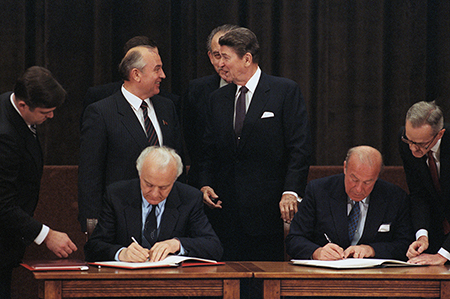
Pressed by a public alarmed about the risk of nuclear war and arms racing, President Ronald Reagan’s team (minus Trump) would painstakingly negotiate an arms control approach with Soviet Leader Mikhail Gorbachev that led to agreements mandating the verifiable elimination of thousands of nuclear weapons.
In 1990, Trump told Playboy, “I’ve always thought about the issue of nuclear war; it’s a very important element in my thought process.” He called it the “ultimate catastrophe.” It certainly would be, and the risk of nuclear war and a new, unconstrained arms race is higher today than it has been since the end of the Cold War.
Unfortunately, Trump, now in his second term as president, so far has failed to achieve his long-ago vision. Rather than negotiate a lasting arms control or nonproliferation agreement, he has withdrawn from or jeopardized existing nuclear restraint agreements, adopted a more aggressive nuclear posture, and exploded the cost of the U.S. nuclear weapons modernization program. On Oct. 29, he threatened to “start testing our nuclear weapons on an equal basis.”
To his credit, however, Trump has expressed repeated interest in denuclearization talks with China and with Russia. In January, he opined: “Tremendous amounts of money are being spent on nuclear, and the destructive capability is something that we don’t even want to talk about.… So, we want to see if we can denuclearize, and I think that’s very possible.”
But Trump and his unorthodox national security team have been unable or unwilling to translate his talk into action. He still has time to do so if he and his advisers develop a coherent, pragmatic, and sustained approach for engaging Russian President Vladimir Putin, Chinese President Xi Jinping, and other leaders.
Trump is certainly no Ronald Reagan, ideologically, temperamentally, or in terms of governance style. If Trump really wants to succeed at denuclearization, he and his team might look to the first Reagan-Gorbachev summit in Geneva in 1985.
Unlike Trump’s three-hour tete-a-tete with Putin in Alaska in August, that summit lasted three days and took more than two months of preparation. Reagan and Gorbachev agreed on several key principles that established a foundation for detailed talks on nuclear arms cuts. They agreed that “a nuclear war cannot be won and must never be fought” and pledged that neither side would seek military superiority.
The two leaders also endorsed the principle of 50-percent reductions in their respective nuclear arsenals, as well as an interim agreement to phase out intermediate-range nuclear-armed missiles. Because these issues are complex and negotiations require give and take, Reagan and Gorbachev also agreed on the need for regular, intense dialogue at various levels to operationalize their top-level directions.
To make concrete progress in today’s complex geostrategic environment, Trump and Putin should formally agree to Putin’s Sept. 22 offer to continue respecting the central limits of the New Strategic Arms Reduction Treaty for at least one year after the treaty expires Feb. 5, 2026, which Trump has called “a good idea.” This would reduce tensions, forestall a costly strategic arms buildup, create leverage to curb China’s nuclear buildup, and buy time for talks on a broader, more durable, follow-on framework deal.
As Reagan and Gorbachev did, Trump and Putin should direct their teams to begin negotiations on a new, more comprehensive agreement on further offensive nuclear constraints and recognize the interrelationship between strategic offensive and defensive forces.
Trump also has a chance to broaden the disarmament effort by inviting China, France, and the United Kingdom to freeze their nuclear forces at the current number of strategic launchers, provided Russia and the United States pursue deeper nuclear cuts. Today, Russia and the United States have fewer than 800 total strategic nuclear launchers each; China has about 550; and France and the UK have a combined total of 96.
Maintaining the de facto nuclear test moratorium and establishing a mutual freeze on strategic launchers would not adversely affect any one country’s nuclear deterrence capabilities; it would provide needed predictability and a basis for bilateral talks on further nuclear restraints and reductions.
Finally, Trump could seek to solidify the joint 1985 declaration that “nuclear war cannot be won and must never be fought” by multilateralizing the forgotten 1973 U.S.-Soviet Prevention of Nuclear War Agreement so that it commits all five major nuclear-armed states to “refrain from the threat or use of force against the other Party, against the allies of the other Party and against other countries.”
The nuclear weapons challenge is one of the most vexing and dangerous. It cannot be solved in an hour or a day, but with persistent, competent, and bold leadership, it can be solved.
Nuclear Abolition: A Scenario
By Timmon Wallis
Indispensable Press, 2025
November 2025
Nuclear Abolition: A Scenario
By Timmon Wallis
Indispensable Press, 2025
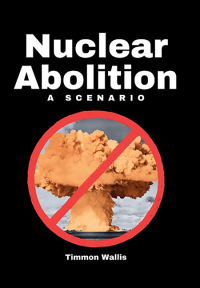
In this book, Timmon Wallis, executive director of NuclearBan.US, presents a detailed and hopeful vision for dismantling nuclear weapons worldwide. The title riffs off the 2024 bestseller, Nuclear War: A Scenario, in which author Annie Jacobson charts the chain of events that could unfold during a nuclear conflict, ending in global devastation. Wallis, in contrast, imagines a step-by-step pathway of activism leading to complete nuclear abolition.
Drawing on extensive interviews with disarmament campaigners and experts from countries as varied as South Africa, Sierra Leone, Australia, and Ireland, Wallis shows that abolishing nuclear weapons is not simply a matter of persuading political leaders; it requires shifting the center of geopolitical gravity toward direct grassroots action. His scenario envisions national and global movements using legal frameworks—from local legislation to multilateral agreements such as the Treaty on the Prohibition of Nuclear Weapons—to delegitimize and even criminalize nuclear arsenals.
Walis emphasizes the power of financial pressure, including divestment campaigns, boycotts, and the targeting of nuclear weapons manufacturers such as General Electric, Ford, and Motorola, as a direct way to disrupt the nuclear weapons industrial complex. He highlights how similar tactics in the 1980s helped lay the groundwork for negotiations leading to the Intermediate-Range Nuclear Forces Treaty. He argues that these remain practical, actionable tools for individuals, communities, and civil society organizations seeking nuclear abolishment today.
By reframing the conversation from “if” nuclear abolition is possible to “how” it can be achieved, Wallis offers a roadmap that is urgent and empowering. His book is a pragmatic call to action that insists that dismantling the world’s most destructive weapons is not only necessary, but achievable through collective will and coordinated effort.—SHAGHAYEGH CHRIS ROSTAMPOUR